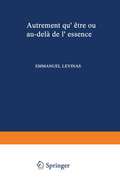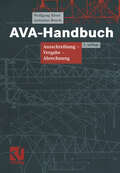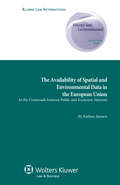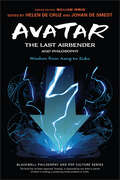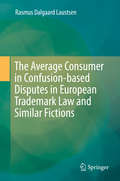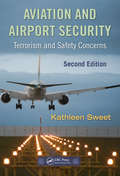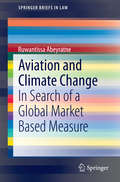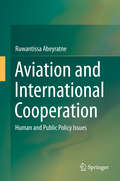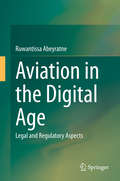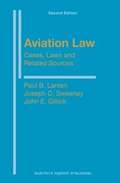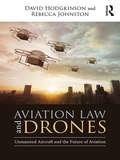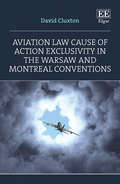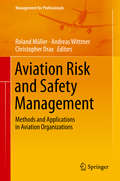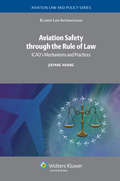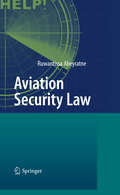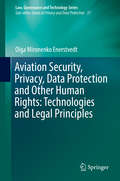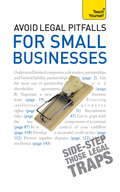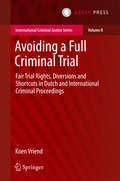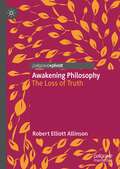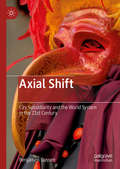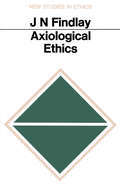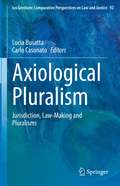- Table View
- List View
AVA-Handbuch: Ausschreibung - Vergabe - Abrechnung
by Wolfgang Rösel Antonius BuschIn diesem praktischen Leitfaden werden alle wesentlichen Regelungen und Zusammenhänge dargestellt, die von der Ausschreibung über die Vergabe bis zur Abrechnung zu beachten sind. Das Geflecht aus dem Zivilrecht (BGB), Vergabe- und Vertragsordnung (VOB), öffentlichem Baurecht und den verschiedenen technischen Regeln wird aus Sicht des Architekten erschlossen. Zahlreiche Beispiele, Grafiken und Formularmuster veranschaulichen die Ausführungen. Dem Text zugeordnete Randziffern verweisen auf die einschlägigen Gesetze und Bestimmungen. Dieses Buch gibt dem Praktiker rechtssichere Hinweise, vermittelt Fachwissen in der Lehre und im Studium und bietet Bauherren wertvolle Unterstützung beim Umgang mit Architekten, Ingenieuren, Handwerkern und Bauunternehmen. Die fünfte Auflage berücksichtigt die Änderungen der VOB 2002 und aktualisiert die Rechtsprechung, neu bearbeitet wurden außerdem der Abschnitt computergestütze EDV.
Availability of Spatial and Environmental Data in the European Union: At the Crossroads between Public and Economic Interests
by Cristos Velasco San MartínThe Availability of Spatial and Environmental Data in the European Union
Avatar: Wisdom from Aang to Zuko (The Blackwell Philosophy and Pop Culture Series)
by William IrwinWould our world be a better place if some of us were benders? Can Katara repair the world through care? Is Toph a disability pride icon? What does it mean for Zuko to be bad at being good? Can we tell whether uncle Iroh is a fool or a sage? The world is out of sorts. The four nations, Water, Earth, Fire, and Air, are imbalanced because of the unrelenting conquest of the Fire Nation. The only one who can restore balance to the world is the Avatar. On the face of it, Avatar: The Last Airbender is a story about a lone superhero. However, saving the world is a team effort, embodied in Team Avatar, aka the Gaang. Aang needs help from his friends and tutors, even from non-human animals. Through the teachings of Guru Pathik and Huu he comes to realize that though the world and its nations seem separate, we are all one people. We all have the same roots and we are all branches of the same tree. Avatar: The Last Airbender and Philosophy brings to the fore the Eastern, Western, and Indigenous philosophies that are implicit in the show. Following Uncle Iroh&’s advice that it is important to draw wisdom from many traditions, this volume features contributions by experts on Buddhist, Daoist, Confucian, and Indigenous schools of thought, next to focusing on Western classical authors such as Plotinus, Kant, and Merleau-Ponty. The volume is also unique in drawing on less common traditions such as black abolitionism, anarchism, and the philosophy of martial arts. Intertwining experience and reflection, ATLA and Philosophy helps readers to deeply engage with today&’s burning questions, such as how to deal with ecological destruction, the aftermath of colonialism and genocide, and wealth inequality, using the tools from a wide range of philosophical traditions.
Avatar: Wisdom from Aang to Zuko (The Blackwell Philosophy and Pop Culture Series)
by William IrwinWould our world be a better place if some of us were benders? Can Katara repair the world through care? Is Toph a disability pride icon? What does it mean for Zuko to be bad at being good? Can we tell whether uncle Iroh is a fool or a sage? The world is out of sorts. The four nations, Water, Earth, Fire, and Air, are imbalanced because of the unrelenting conquest of the Fire Nation. The only one who can restore balance to the world is the Avatar. On the face of it, Avatar: The Last Airbender is a story about a lone superhero. However, saving the world is a team effort, embodied in Team Avatar, aka the Gaang. Aang needs help from his friends and tutors, even from non-human animals. Through the teachings of Guru Pathik and Huu he comes to realize that though the world and its nations seem separate, we are all one people. We all have the same roots and we are all branches of the same tree. Avatar: The Last Airbender and Philosophy brings to the fore the Eastern, Western, and Indigenous philosophies that are implicit in the show. Following Uncle Iroh&’s advice that it is important to draw wisdom from many traditions, this volume features contributions by experts on Buddhist, Daoist, Confucian, and Indigenous schools of thought, next to focusing on Western classical authors such as Plotinus, Kant, and Merleau-Ponty. The volume is also unique in drawing on less common traditions such as black abolitionism, anarchism, and the philosophy of martial arts. Intertwining experience and reflection, ATLA and Philosophy helps readers to deeply engage with today&’s burning questions, such as how to deal with ecological destruction, the aftermath of colonialism and genocide, and wealth inequality, using the tools from a wide range of philosophical traditions.
The Average Consumer in Confusion-based Disputes in European Trademark Law and Similar Fictions
by Rasmus Dalgaard LaustsenThis book contends that, with regard to the likelihood of confusion standard, European trademark law applies the average consumer incoherently and inconsistently. To test this proposal, it presents an analysis of the horizontal and vertical level of harmonization of the average consumer. The horizontal part focuses on similar fictions in areas of law adjacent to European trademark law (and in economics), and the average consumer in unfair competition law. The vertical part focuses on European trademark law, represented mainly by EU trademark law, and the trademark laws of the UK, Sweden, Denmark and Norway. The book provides readers with a better understanding of key aspects of European trademark law (the average consumer applied as part of the likelihood of confusion standard) and combines relevant law and practices with theoretical content and other related areas of law (and economics). Accordingly, it is an asset for policymakers and practitioners, as well as general readers with an interest in intellectual property law and theory.
Aviation and Airport Security: Terrorism and Safety Concerns, Second Edition
by Kathleen SweetThe Definitive Handbook on Terrorist Threats to Commercial Airline and Airport SecurityConsidered the definitive handbook on the terrorist threat to commercial airline and airport security, USAF Lieutenant Colonel Kathleen Sweet‘s seminal resource is now updated to include an analysis of modern day risks. She covers the history of aviation security
Aviation and Climate Change: In Search of a Global Market Based Measure (SpringerBriefs in Law)
by Ruwantissa AbeyratneThe book addresses the most critical issue faced by aviation and climate change: namely the development of a market based measure to control aircraft engine emissions. It discusses the current market economic trends as they impact to aviation and suggests steps and measures to be taken in the development of a workable MBM. ICAO has three years to come up with such an MBM on a global scale and this book will spur discussions on how to achieve this objective.
Aviation and International Cooperation: Human and Public Policy Issues
by Ruwantissa AbeyratneThis book addresses an essential gap in the regulatory regime, which provides legislation, statements and guidelines on airlines, airports, air navigation services providers and States in the field of aviation, but is notably lacking when it comes to the rights of the airline passenger, and the average citizen who is threatened by military air strikes. It addresses subjects such as international resolutions on human rights and other human rights conventions related to aviation that impact both air transport consumers and people on the ground who are threatened by air strikes through drone attacks; disabled and obese airline passengers; compensation for delayed carriage and the denial of carriage; noise and air pollution caused by aviation and their effects on human health and wellbeing; prevention of death or injury to passengers and attendant compensatory rights; risk management; relief flights; and racial profiling. These subjects are addressed against the backdrop of real case studies that include but are not limited to instances of drone attacks, and contentious flights in the year 2014 such as MH 370, MH 17 and QZ 8501.
Aviation in the Digital Age: Legal and Regulatory Aspects
by Ruwantissa AbeyratneAll of the topics discussed in this book – from sovereignty to cybercrime, and from drones to the identification of passengers & privacy – are profoundly affected by algorithms; so are air traffic services and aeronautical communications. All of these aviation-related aspects are addressed in a 75-year-old treaty called the Chicago Convention and its Annexes, which, as this book argues, needs to be reviewed with a focus on its relevance and applicability in connection with Moore’s Law, which posits that transistors in computer microchips double in speed, power and performance every two years, while the cost of computers is halved during the same period. Firstly, in terms of traditional territorial sovereignty, we have arrived at a point where there is a concept of data sovereignty and ownership that raises issues of privacy. Data transmission becomes ambivalent in terms of territorial sovereignty, and the Westphalian model may not be the perfect answer. Whether it be the manufacture of airplanes, the transfer of data on individuals, or the transmission of aeronautical and telecommunications information – all have to be carried out in accordance with the same fundamental principle: duty of care. Against the backdrop of the relevant provisions of the Chicago Convention and its Annexes, the detailed analysis presented here covers key areas such as: megatrends; AI and international law in the digital age; blockchain and aviation; drones; aviation and telecommunications; aviation and the Internet; cybersecurity; and digital identification of passengers & privacy. In turn, the book suggests how we can best manage this transition.
Aviation Law: Cases, Laws And Related Sources
by Paul B. Larsen John E. Gillick Joseph C. SweeneyThe flying public, airlines, and governments will all agree on one date that changed commercial flying: that was September 11, 2001. The first edition of Aviation Law: Cases, Laws and Related Sources, described early consequences of that event, particularly compensation of victims and early tightening of aviation security. Subsequently laws and regulations affecting all aspects of aviation changed so rapidly that it became difficult to set a cut-off date for the second edition. The rapid flow of events made an update urgent.
Aviation Law and Drones: Unmanned Aircraft and the Future of Aviation
by David Hodgkinson Rebecca JohnstonThe aviation industry is being transformed by the use of unmanned aerial vehicles, or drones – commercially, militarily, scientifically and recreationally. National regulations have generally failed to keep pace with the expansion of the fast-growing drone industry. Aviation Law and Drones: Unmanned Aircraft and the Future of Aviation traces the development of aviation laws and regulations, explains how aviation is regulated at an international and national level, considers the interrelationship between rapidly advancing technology and legislative attempts to keep pace, and reviews existing domestic and international drone laws and issues (including safety, security, privacy and airspace issues). Against this background, the book uniquely proposes a rationale for, and key provisions of, guiding principles for the regulation of drones internationally – provisions of which could also be implemented domestically. Finally, the book examines the changing shape of our increasingly busy skies – technology beyond drones and the regulation of that technology. The world is on the edge of major disruption in aviation – drones are just the beginning. Given the almost universal interest in drones, this book will be of interest to readers worldwide, from the academic sector and beyond.
Aviation Law and Drones: Unmanned Aircraft and the Future of Aviation
by David Hodgkinson Rebecca JohnstonThe aviation industry is being transformed by the use of unmanned aerial vehicles, or drones – commercially, militarily, scientifically and recreationally. National regulations have generally failed to keep pace with the expansion of the fast-growing drone industry. Aviation Law and Drones: Unmanned Aircraft and the Future of Aviation traces the development of aviation laws and regulations, explains how aviation is regulated at an international and national level, considers the interrelationship between rapidly advancing technology and legislative attempts to keep pace, and reviews existing domestic and international drone laws and issues (including safety, security, privacy and airspace issues). Against this background, the book uniquely proposes a rationale for, and key provisions of, guiding principles for the regulation of drones internationally – provisions of which could also be implemented domestically. Finally, the book examines the changing shape of our increasingly busy skies – technology beyond drones and the regulation of that technology. The world is on the edge of major disruption in aviation – drones are just the beginning. Given the almost universal interest in drones, this book will be of interest to readers worldwide, from the academic sector and beyond.
Aviation Law Cause of Action Exclusivity in the Warsaw and Montreal Conventions
by David CluxtonThis incisive book tackles a controversy that has plagued the Warsaw Convention 1929 and the Montreal Convention 1999 for decades: whether the conventions provide an independent cause of action upon which a plaintiff can rely directly when pleading their action, and, if so, whether that cause of action provides the exclusive remedy. This book resolves this controversy by presenting a new conceptual framework for understanding aviation law cause of action in the conventions.Written in a scholarly yet engaging style, this insightful book reveals foundational concepts for the conventions’ regimes, from the legal relationships they govern, to the manner of their implementation in national law. Employing legal history and comparative law to support his arguments, David Cluxton enriches the doctrinal analysis with an in-depth academic study of the legal background to, and drafting history of, the Warsaw Convention, the subsequent development of the relevant issues, and the case law and commentary thereon.Aviation Law Cause of Action Exclusivity in the Warsaw and Montreal Conventions will be a valuable resource for scholars and students of private air law, private international law and dispute resolution, while also being of great interest to aviation law practitioners and aviation insurers and policy-makers.
Aviation Risk and Safety Management: Methods and Applications in Aviation Organizations (Management for Professionals)
by Roland Müller Andreas Wittmer Christopher DraxThe International Civil Aviation Organization’s (ICAO) decision to require aviation organizations to adopt Safety Management Systems poses a major problem especially for small and medium sized aviation companies. The complexity of regulations overstrains the aviation stakeholders who seek to fully advantage from them but have no clear guidance. The aim of the book is to show the implementation of such a new system with pragmatic effort in order to gain a gradation for smaller operators. This approach should illustrate the leeway in order to adapt the processes and to show the interfaces between Corporate Risk Management and Safety Management. The book shows how to build a system with reasonable effort, appropriate to the size and complexity of the specific operator. It also gives inputs on the key aspects and how to effectively operate such a system with the various interfaces. Furthermore, the book highlights the importance of Corporate Risk Management independent of Safety Management Systems based on ICAO.
Aviation Safety through the Rule of Law: ICAO's Mechanisms and Practices
by J. HuangFlight is inherently a risky venture, carried out in a hostile environment at great speed. Realistically and regrettably, a commitment to aviation safety can achieve no more than ‘as few accidents as possible’. Moreover, the tragic events of 11 September 2001 have conclusively demonstrated that aviation safety goes beyond accident prevention from a technical point of view and extends to more profound political, strategic and legal dimensions. Accordingly, aviation safety requires a multidisciplinary approach: technical, economic, managerial, and legal. This ground-breaking study analyzes, from a legal point of view, the mandate of the International Civil Aviation Organization (ICAO) relating to aviation safety in the light of changes which have taken place since the conclusion of the Chicago Convention, including the expansion of the international civil aviation community, the liberalization of the aviation industry, the introduction of new technology, and existing as well as new and emerging terrorist threats. The author clearly demonstrates that ICAO, as the worldwide governmental organization for international civil aviation, should be allowed a more proactive role in enhancing aviation safety. Describing in great detail the contributions of ICAO to the global safety regime and mechanisms, he submits effective ways to rationalize ICAO’s quasi-legislative and enforcement functions in order to enhance aviation safety through the rule of law. Among the important topics arising in the course of the analysis are the following: global ramifications of national and regional initiatives; auditing of state compliance with international standards; characterization of crimes against the safety of civil aviation; importance of ensuring that safety requirements are not compromised by profit considerations; burgeoning of airline alliances, code-sharing and outsourcing activities; demands for simplification and unification of certain regulatory procedures; prohibition of the use of weapons against civil aircraft in flight; development of new technology, such as satellite-based navigation systems; and importance of the rule of law and the system of checks and balances in international organizations. As a plea to consider civil aviation safety obligations not only as merely contractual obligations between States but as obligations owed to the international community as a whole, this book is sure to give rise to far-reaching discussions and follow-up among policymakers and the interested legal community in the years to come.
Aviation Security Law
by Ruwantissa AbeyratneThe law plays a significant role in ensuring aviation security. This book addresses new and emerging threats to civil aviation; evaluates security tools now in use such as the Public Key Directory, Advance Passenger Information, Passenger Name Record and Machine Readable travel documents in the context of their legal and regulatory background; and discusses applicable security treaties while providing an insight into the process of the security audits conducted by the International Civil Aviation Organization (ICAO). The book also examines issues of legal responsibility of States and individuals for terrorist acts of third parties against civil aviation and discusses from a legal perspective the latest liability Conventions adopted at ICAO. The Conclusion of the book provides an insight into the application oflegal principles through risk management.
Aviation Security, Privacy, Data Protection and Other Human Rights: Technologies and Legal Principles (Law, Governance and Technology Series #37)
by Olga Mironenko EnerstvedtThis book sheds light on aviation security, considering both technologies and legal principles. It considers the protection of individuals in particular their rights to privacy and data protection and raises aspects of international law, human rights and data security, among other relevant topics. Technologies and practices which arise in this volume include body scanners, camera surveillance, biometrics, profiling, behaviour analysis, and the transfer of air passenger personal data from airlines to state authorities.Readers are invited to explore questions such as: What right to privacy and data protection do air passengers have? How can air passenger rights be safeguarded, whilst also dealing appropriately with security threats at airports and in airplanes? Chapters explore these dilemmas and examine approaches to aviation security which may be transferred to other areas of transport or management of public spaces, thus making the issues dealt with here of paramount importance to privacy and human rights more broadly. The work presented here reveals current processes and tendencies in aviation security, such as globalization, harmonization of regulation, modernization of existing data privacy regulation, mechanisms of self-regulation, the growing use of Privacy by Design, and improving passenger experience. This book makes an important contribution to the debate on what can be considered proportionate security, taking into account concerns of privacy and related human rights including the right to health, freedom of movement, equal treatment and non-discrimination, freedom of thought, conscience and religion, and the rights of the child. It will be of interest to graduates and researchers in areas of human rights, international law, data security and related areas of law or information science and technology. I think it will also be of interest to other categories (please see e.g. what the reviewers have written)"I think that the book would be of great appeal for airports managing bodies, regulators, Civil Aviation Authorities, Data Protection Authorities, air carriers, any kind of security companies, European Commission Transport Directorate, European Air Safety Agency (EASA), security equipment producers, security agencies like the US TSA, university researchers and teachers.""Lawyers (aviation, privacy and IT lawyers), security experts, aviation experts (security managers of airports, managers and officers from ANSPs and National Aviation Authorities), decision makers, policy makers (EASA, EUROCONTROL, EU commission)"
Avizandum Statutes on Scots Property, Trusts and Succession Law 2015–2016 (12th Edition) (PDF)
by Andrew J M Steven Scott WortleyPlease note: The 12th edition is now out of date. A new edition has been published.
Avoid Legal Pitfalls for Small Businesses: An essential reference guide to law and litigation for SMEs (Teach Yourself)
by Bevans SolicitorsDo you want to protect yourself from all the legal pitfalls in planning, setting up and running your SME? Then let one of the UK's leading law firms guide you through the minefield with this book - the best quick reference to all of those risks and how to avoid them, With a practical approach that takes you from: Pre-start up ( Operating structures; Restrictions preventing start up; Corporate finance considerations) Through start-up (Shareholder/partnership agreements and exit strategies; Property/premises issues; Employment of staff, including drafting contracts of employment; Supplier contracts; Customer/client contracts; Protecting IP rights) To practical ongoing SME pitfalls (IP rights and disputes; Owner disputes; HR/employee problems; Health and Safety problems; PI claims and HSE prosecutions; Supplier disputes; Customer disputes including debt collection; Merger & Acquisitions activity including issues related to disposing of a business)This invaluable book could save you from legal and financial disaster: a great value resource for every small to medium business.
Avoiding a Full Criminal Trial: Fair Trial Rights, Diversions and Shortcuts in Dutch and International Criminal Proceedings (International Criminal Justice Series #8)
by Koen VriendIn modern societies, full criminal trials are avoided on many occasions. This book is concerned with mechanisms that either divert from or speed up the proceedings.Koen Vriend argues that the fair trial rights as established by the European Court of Human Rights under Article 6 ECHR provide a normative framework that does not only apply in a full criminal trial, but that it can also be used for diverted and shortened proceedings. He shows that the concept of fairness—as derived from ECtHR case law—is a fundamental principle that underlies all criminal law enforcement. It provides for the appropriate framework to assess whether diverted or shortened proceedings are fair and legitimate.The book is intended for criminal law scholars and practitioners and human rights scholars.Dr. Koen Vriend is a Lecturer of Criminal Law and Criminal Procedural Law at the University of Amsterdam.
Awakening Philosophy: The Loss of Truth
by Robert Elliott AllinsonIn this original book, Robert Elliott Allinson asserts that philosophers have been lulled into a dogmatic sleep by Immanuel Kant, the slayer of metaphysics, who has convinced them (and the rest of humanity) that we can never know Reality. Allinson awakens global philosophers from their sceptical slumbers by diagnosing the reason why they have abdicated their traditional calling as leaders of inquiry into truth and wisdom.
Axial Shift: City Subsidiarity and the World System in the 21st Century
by Benjamen GussenThis book uses historical analysis, constitutional economics, and complexity theory to furnish an account of city subsidiarity as a legal, ethical, political, and economic principle. The book contemplates subsidiarity as a constitutional principle, where cities would benefit from much wider local autonomy. Constitutional economics suggests an optimal limit to jurisdictional footprints (territories). This entails preference for political orders where sovereignty is shared between different cities rather states where capital cities dominate. The introduction of city subsidiarity as a constitutional principle holds the key to economic prosperity in a globalizing world. Moreover, insights from complexity theory suggest subsidiarity is the only effective response to the ‘problem of scale.’ It is a fitness trait that prevents highly complex systems from collapsing. The nation-state is a highly complex system within which cities function as ‘attractors.’ The collapse of such systems would ensue if there were strong coupling between attractors. Such coupling obtains under legal monism. Only subsidiarity can make the eventuality of collapse improbable. The emergent and self-organizing properties of subsidiarity entail a shift in policy emphasis towards cities with a wide margin of autonomy.
Axiological Pluralism: Jurisdiction, Law-Making and Pluralisms (Ius Gentium: Comparative Perspectives on Law and Justice #92)
by Lucia Busatta Carlo CasonatoThis book analyses the features and functionality of the relationship between the law, individual or collective values and medical-scientific evidence when they have to be interpreted by judges, courts and para-jurisdictional bodies. The various degrees to which scientific data and moral values have been integrated into the legal discourse reveal the need for a systematic review of the options and solutions that judges have elaborated on. In turn, the book presents a systematic approach, based on a proposed pattern for classifying these various degrees, together with an in-depth analysis of the multi-layered role of jurisdictions and the means available to them for properly handling new legal demands arising in plural societies.The book outlines a model that makes it possible to focus on and address these issues in a sustainable manner, that is, to respond to individual requests and technological advances in the field of biolaw by consistently and effectively applying suitable legal instruments and jurisdictional interpretation.
